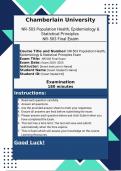Chamberlain University
NR- 503 Population Health, Epidemiology &
Statistical Principles
NR- 503 Final Exam
Course Title and Number: NR-503 Population Health,
Epidemiology & Statistical Principles Exam
Exam Title: NR-503 Final Exam
Exam Date: Exam 2024- 2025
Instructor: [Insert Instructor’s Name]
Student Name: [Insert Student’s Name]
Student ID: [Insert Student ID]
Examination
180 minutes
Instructions:
1. Read each question carefully.
2. Answer all questions.
3. Use the provided answer sheet to mark your responses.
4. Ensure all answers are final before submitting the exam.
5. Please answer each question below and click Submit when you
have completed the Exam.
6. This test has a time limit, The test will save and submit
automatically when the time expires
7. This is Exam which will assess your knowledge on the course
Learning Resources.
Good Luck!
Need Writing Help? We've Got You Covered! ✍️
100%
NO AI or Plagiarism Usage Guaranteed🎯
💬 Chat with us here: 📧 Hybridgrades101@gmail.com
, NR-503 Population Health, Epidemiology & Statistical
Principles 2024-2025
NR-503 Final Exam Practice Test Questions with
Verified Solutions | 100% Pass Guaranteed | Graded A+
|
Read All Instructions Carefully and Answer All the
Questions Correctly Good Luck: -
How is the epidemiological triangle related to
pandemics, outbreaks? - Answer>> 1. A recent
increase in amount or virulence of the agent,
2. The recent introduction of the agent into a setting
where it has not been before,
3. An enhanced mode of transmission so that more
susceptible persons are exposed,
4. A change in the susceptibility of the host response to
the agent, and/or
5. Factors that increase host exposure or involve
introduction through new portals of entry
If you were to explain "disaster epidemiology" to a
colleague or nursing student, what would you say? -
Answer>> the use of epidemiology to assess the
short- and long-term adverse health effects of disasters
and to predict consequences of future disasters. It
brings together various topic areas of epidemiology
including acute and communicable disease,
environmental health, occupational health, chronic
disease, injury, mental health, and behavioral health
What is the WHO? What do the SDG's (formerly MDG'S)
mean? - Answer>> As the MDGs era came to an end
in 2015, WHO responded with the official launch of
Need Writing Help? We've Got You Covered! ✍️
100%
NO AI or Plagiarism Usage Guaranteed🎯
💬 Chat with us here: 📧 Hybridgrades101@gmail.com
,SDGs The new Agenda calls on countries to begin
efforts to achieve 17 SDGs by 2030
What is the history of the World Health Organization? -
Answer>> created in 1946, as part of the UN, to find
solutions for post-World War II Europe. Any member
country of the UN can be a member of WHO
How do you assess an area's resources and its
relationship to the health of a region? - Answer>> By
focusing on Population health take into account the
emergent properties of social structure, such as cultural
norms, poverty, social policies, and distribution of
primary care physicians, in conjunction with microlevel
properties, such as genetics, gender, ethnicity,
educational level, and individual health behaviors.
fairness - Answer>> the state, condition, or quality of
being fair, or free from bias or injustice;
evenhandedness.
Ethics - Answer>> the principles of right and wrong
that guide an individual in making decisions
Social justice - Answer>> the fair and equitable
distribution of power, resources, and obligations in
society to all people, regardless of race or ethnicity,
age, gender, ability status, sexual orientation, and
religious or spiritual background
How do ethics and public policy intersect? - Answer>>
they intersect when connecting social justice theory to
advocacy, health disparities and to outcomes.
Need Writing Help? We've Got You Covered! ✍️
100%
NO AI or Plagiarism Usage Guaranteed🎯
💬 Chat with us here: 📧 Hybridgrades101@gmail.com
, The key to social justice is improving health outcomes
AND simultaneously improving the social gradient and
reducing health inequalities
What influence do you as a provider have regarding
public policy? What ethical obligation do you believe
you have? - Answer>> APRNs are expected to provide
health promotion and risk reduction and illness
prevention for individuals and populations.
No longer can APNs focus on individuals; they must
practice based on aggregates of populations that share
a common characteristic
ie: pregnant teen mothers
How is risk reduction, assessment, and outcomes
related to public health policy? - Answer>> no longer
feasible or realistic for one provider to do it all must
partner with community agencies and be aware of the
resources each community partner offers to promote
health and reduce disease chronicity.
Where is the intersection of: epidemiology, population
health, public policy and social justice and vulnerable
populations? - Answer>> Where is the intersection of:
epidemiology, population health, public policy and
social justice and vulnerable populations?
One of the primary objectives of epidemiological
science is to create public policies and plans to help in
the prevention and improve outcomes of disease
ie: banning smoking indoors
veracity - Answer>> accuracy, truthfulness
beneficency - Answer>> to do good
non-maleficence - Answer>> do no harm
Need Writing Help? We've Got You Covered! ✍️
100%
NO AI or Plagiarism Usage Guaranteed🎯
💬 Chat with us here: 📧 Hybridgrades101@gmail.com




